Computer Security Threat Monitoring and Surveillance
Computer Security Threat Monitoring and Surveillance
Computer Security Threat Monitoring and Surveillance
Create successful ePaper yourself
Turn your PDF publications into a flip-book with our unique Google optimized e-Paper software.
If (for purposes of illustration) we asstune that the 'A' data<br />
is the average (or cumulative) experience with the user in question,<br />
the variability in time of use could be scored by summing the squares<br />
of absolute values of the difference, i.e.,<br />
24<br />
score , = E \(A. - B.) 12<br />
i=l l. l.<br />
While not a particularly elegant measure, it does show for the several<br />
users represented, those whose logon pattern exhibit greatest varia<br />
bility, which might be the result of masquerade. Depending on other<br />
measures, those users might then become subjects of additional in<br />
vestigations.<br />
The time of use abnormality scores for the five samples are:<br />
User Score<br />
I 0<br />
II 8<br />
III 107<br />
IV ll<br />
v 41<br />
Depending on where the cutoff point is set for reporting, one<br />
would expect to see 'III' <strong>and</strong> 'V' reported as being out of range.<br />
In addition to the elapsed real time for a particular problem, we<br />
can measure the actual computer time used on a particular problem.<br />
This measure should not vary substantially, but a heavy system load<br />
which causes programs to be swapped in <strong>and</strong> out frequently can in<br />
crease the elapsed running time for the problem. The increase<br />
should not be significant unless there is some other reason.
















